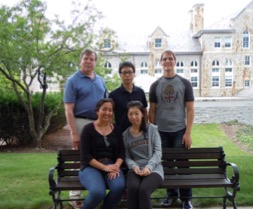
Sherman Fairchild Professor
Department of Physics, Lehigh University
16 Memorial Drive East, Bethlehem, PA 18015
Phone: (610) 758-3946
e-mail: mjsa@lehigh.edu
Education
Ph.D., Physics, University of Rochester, 1980
B.S., Physics and Engineering, Trinity College, 1975
Employment
Sherman Fairchild Professor of Physics, Lehigh University, 2005 - present
Assoc. Dean, Research and Graduate Programs, 2009 - 2012
Chair, Department of Physics, Lehigh University, 2003 –2009, 2021- present
Professor of Physics, Lehigh University, 1993 - present
Director, Fairchild Laboratory for Solid State Studies, 1995 - 1997
Associate Professor of Physics, Lehigh University, 1989 - 1993
Visiting Scientist, Lund University, Lund, Sweden, Fall, 1985
Member of Technical Staff, Bell Laboratories, Murray Hill, 1980 - 1989
Awards and Honors
Libsch Research Award (Lehigh’s annual faculty research award), 2014
Fellow of the Institute of Physics (United Kingdom), 2011
Humboldt Research Award for Senior US Scientists, 2003
Fellow of the American Physical Society, 1994
Individual Performance Award, AT&T Bell Laboratories, 1986
Biography
Michael Stavola received his Ph.D. in Physics from the University of Rochester under the supervision of D.L. Dexter in 1980 and was a member of the technical staff at Bell Laboratories, Murray Hill, from 1980-1989. Stavola then joined the faculty of Lehigh University where he is the Sherman Fairchild Professor of Physics. He is chair of the Department of Physics (2003-2009, 2021-present) and was Associate Dean in the College of Arts and Sciences (2009-2012). The focus of Stavola’s research has been on the physics of light-element impurities in semiconductors, especially hydrogen. His IR studies of the vibrational modes of various hydrogen-containing defects in semiconductors has served as a major source of experimental understanding of this important class of defects. Stavola extends his fundamental studies of defects to include important applications with a recent example being the detection of hydrogen introduced into Si by processes used to fabricate solar cells. While Stavola’s most sustained effort has been on the hydrogen impurity in semiconductors, the common thread that extends throughout his work is the insightful use of spectroscopy to extract key experimental information.
Stavola was co-chair of the 16th International Conference on Defects in Semiconductors, chair of the Gordon Conference on Defects in Semiconductors in 1994, and has co-chaired several DMP focus sessions on Defects in Semiconductors.
Research on defects in semiconductors and transparent conducting oxides
Understanding defects and impurities is essential to understanding electronic and photonic materials and the devices made from them. The goal of Stavola’s research program is to determine and understand the fundamental properties of defects in semiconductors and transparent conducting oxides that are important in technology. For example, vibrational spectroscopy is used to investigate the structures and properties of defects that contain light-element impurities such as H, C, O, and N that play an important role in determining the electronic properties of semiconductors such as Si, GaN, ZnO and GaAsN that are of current technological interest. Our recent research is focused on the effect of H on the conductivity of transparent conducting oxides.

